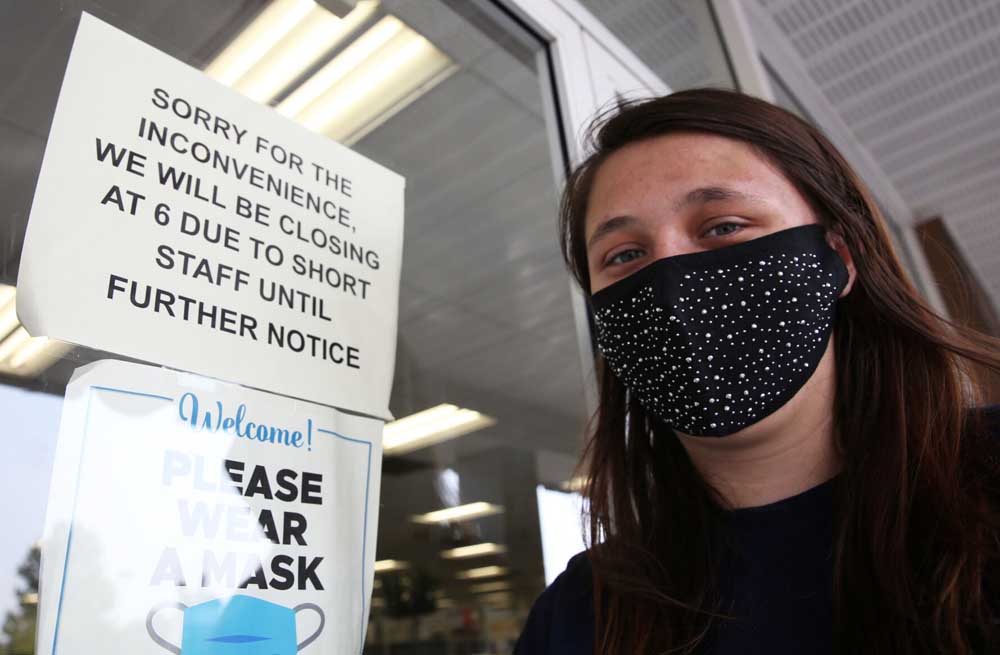Getting creative to lure back workers
Published 12:15 am Thursday, September 16, 2021

- MacKenzee Scott, manager of Tuesday Morning in Bend, stands with a sign stating reduced hours of operation due to a lack of workers. Scott can’t keep the store open for the chain’s dedicated hours. The Bend store closes each night at 6 p.m. instead of 8 p.m. because there’s not enough managers to staff the shifts, Scott said.
BEND — Filling vacant positions and figuring out future growth will take creative thinking at St. Charles Health System.
Trending
Hiring managers at central Oregon’s four-hospital system are reaching out to schools, colleges and medical associations looking for workers to fill the 691 vacant positions. The hospital system is offering signing bonuses, free education for those already working but who want to become a frontline caregiver and referral bonuses, said Rebecca Berry, St. Charles Health System’s vice president of human resources.
The fallout of the hiring crisis in Oregon is that employers have dramatically changed how they do business: Doctors have delayed elective surgeries, retailers have reduced business hours and companies have increased wages and embraced aggressive hiring practices.
And companies have been forced to think about growth at a time when it’s difficult to maintain the status quo.
Trending
Not only is St. Charles trying to fill vacant positions created by workers leaving or retiring, but it’s trying to anticipate future growth and hire to accommodate that, Berry said. With more than 2,000 elective surgeries postponed because they may require an overnight stay at the regional hospital, and a patient load running at 85% on average, the hospital system has to anticipate where the growth might be.
“Now we run new employee orientations twice a month,” Berry said. “Some of our hiring needs are because of anticipated growth and the high level of patient census. So we need more workers. We’re trying to grow with a plan in place.”
St. Charles is just one example of how the worker shortage has changed workplace culture.
The staffing situation has gotten so dire at Tuesday Morning, a houseware retailer at the Bend Factory Stores, that MacKenzee Scott can’t keep the store open for the chain’s dedicated hours. The Bend store closes each night at 6 p.m. instead of 8 p.m. because there’s not enough managers to staff the shifts, Scott said.
“We don’t have enough managers to cover all the days,” Scott said. “No one is applying. I’ve had multiple ads up. Before this COVID-19 stuff I’d have no problem finding help.”
Labor pool challenge
Central Oregon’s ready labor pool used to be one of its key attractions for new businesses seeking to set up shop, said Roger Lee, Economic Development for Central Oregon CEO.
“Our region’s ever-expanding population due to steady in-migration, workforce and human talent availability was our leading strength in attracting new employers and growing businesses already located here,” Lee said. “For many of our client companies, full staffing is the biggest impediment to operations and growth.”
At Nosler, a Bend and Redmond ammunition manufacturer, in order to keep up with demand, the company has added shifts to its production line, which is breaking records, making and shipping to keep up with the pandemic demand to dealers and distributors, but with fewer workers.
The company has added more staff already and offers overtime to keep up with demand. Currently, the company has 62 positions open and those vacancies are affecting production.
“We’ve been interviewing for employees since September 2020,” said Donelle Snider, Nosler’s human resources director. “We have experienced some attrition, but also have increased our workforce production.”
Like many other businesses, Nosler has cast a wide net on various platforms to attract new workers. At WorkSource Oregon, Mike Derrickson, the central Oregon health care recruiter, said he’s coached many employers on how to reach job candidates.
In this tight labor market, available employees often get contacted within minutes of posting their resume. Many employers snag employees for an interview and make immediate job offers, Derrickson said.
“It’s been something else,” Derrickson said. “I have a lot of job seekers who come and I help them with their resume or enroll in classes, make the introduction to an employer and before I’m done, they’re hired by another company.
“We’re seeing employers reacting very quickly.”
Employers offering less than $15 a hour, especially in hard-to-fill industries like leisure and hospitality, are often outbid by employers paying more, said Chris Petty, the Express Employment Professionals franchise manager. Wages have risen in the past year, and employers are willing to train.
“Industrial jobs started nine months ago at $14 an hour and now are going for $18 an hour,” Petty said. “Clients are understanding that they have to pay to get the talent.”
There are so few workers these days, Petty said that a five-hour job fair drew 18 applicants. That was a month ago, Petty said.
Talk to Samuel Lambert, Mid Oregon Personnel vice president, and he’ll tell you that it’s because the government has paid people to stay home.
“The government is paying people not to go to work,” Lambert said. “That’s where all the workers are. We had more applicants when the unemployment was not so readily available.”
Many of the federal unemployment programs expired on Labor Day weekend, according to the Oregon Employment Department. Roughly 81,000 people will no longer receive unemployment benefits.
Petty said he’s heard that companies have expanded their search beyond their communities and now are offering remote work to people. And some people are opting for the freedom of self-employment by becoming Uber, Lyft or Door Dash drivers, said Petty.
Workers returning to the fold
But the employment picture is looking up for employers, Petty said. In just the past couple of weeks, more prospective employees are seeking work. They’re keeping interview appointments.
At St. Charles, Berry said the hospital system, which is the largest employer in the region with more than 4,500 workers, has hired 111 people already and has 115 workers who have accepted positions. Until the new hires come on board, the hospital has staffed its ranks with traveling nurses, members of the Oregon National Guard for nonmedical services and the state has sent in clinical assistance.
“But our journey is not over,” Berry said. “We have more work to do.”
Between the nurse residency program and a certified nursing assistant program partnership with Central Oregon Community College, another 60 medical personnel are now in training for future employment. The hospital and college have doubled enrollment in the program that allows for employees to get paid and train for a certified nursing assistant position.
“We’ll have to be creative on how we recruit,” Berry said. “We have to stretch ourselves to look at the problem (of staffing) differently. We’re looking internally on how to grow our own staff.”









